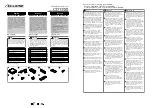
16 • Frequency Response and Noise
NEW FOCUS, Inc.
bandwidth signal-to-noise ratio of 1 is achieved
around 120 pW.
Note that this assumes operation without any post-
photoreceiver filtering and with the full photoreceiver
bandwidth. By using the built-in electronic band-pass
filter or an optical chopper and a lock-in amplifier, the
receiver can detect significantly weaker optical signals.
Performance Data for Frequency Response
The 3-dB frequency bandwidth is defined as the
frequency where the photoreceiver’s transimpedance
gain has decreased by a factor of
. The typical
frequency responses for the Model 2051 and Model
2053 are shown in the following figures.
Figure 3:
Typical
frequency
response for
Model 205X at
each gain
setting
2
Gain Setting=1
-15
-12
-9
-6
-3
0
3
0.01
0.1
1
10
100
Frequency (MHz)
Normalized Gain (dB)
x1
x3
Gain Setting=10
-12
-9
-6
-3
0
3
0.01
0.1
1
10
100
Frequency (MHz)
Normalized Gain (dB)
x1
x3
205x 10MHz Adj Rcvr revA.fm Page 16 Monday, January 10, 2005 9:29 AM
Artisan Technology Group - Quality Instrumentation ... Guaranteed | (888) 88-SOURCE | www.artisantg.com










































